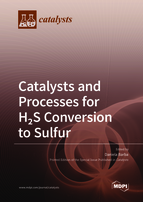Catalysts and Processes for H2S Conversion to Sulfur
A special issue of Catalysts (ISSN 2073-4344). This special issue belongs to the section "Environmental Catalysis".
Deadline for manuscript submissions: closed (31 August 2021) | Viewed by 32120
Special Issue Editor
Interests: heterogeneous catalysis; chemical engineering; preparation and characterization of catalysts; environmental pollution; H2 production
Special Issue Information
Dear Colleagues,
Today, more stringent regulations on SOx emissions and growing environmental concerns have led to considerable attention on sulfur recovery from hydrogen sulfide (H2S). Hydrogen sulfide is commonly found in raw natural gas and biogas, even if a great amount is obtained through sweetening of sour natural gas and hydrodesulphurization of light hydrocarbons. It is highly toxic, extremely corrosive and flammable, and for these reasons, its elimination is necessary prior to emission in atmosphere. There are different technologies for the removal of H2S, the drawbacks of which are the high costs and limited H2S conversion efficiency. The main focus of this Special Issue will be on catalytic oxidation processes, but the issue is devoted to the development of catalysts able to maximize H2S conversion to sulfur minimizing SO2 formation, pursuing the goal of “zero SO2 emission”. The Special issue welcomes short communications, original research papers, and review papers concerning the formulation of novel catalysts for the optimization of the traditional processes or for new technologies. Submissions are welcome in the following areas:
- Preparation, physical–chemical characterization of novel catalysts;
- Optimization of the catalyst formulation and operating conditions;
- Study of the reaction mechanism and deactivation phenomena.
Dr. Daniela Barba
Guest Editor
Manuscript Submission Information
Manuscripts should be submitted online at www.mdpi.com by registering and logging in to this website. Once you are registered, click here to go to the submission form. Manuscripts can be submitted until the deadline. All submissions that pass pre-check are peer-reviewed. Accepted papers will be published continuously in the journal (as soon as accepted) and will be listed together on the special issue website. Research articles, review articles as well as short communications are invited. For planned papers, a title and short abstract (about 100 words) can be sent to the Editorial Office for announcement on this website.
Submitted manuscripts should not have been published previously, nor be under consideration for publication elsewhere (except conference proceedings papers). All manuscripts are thoroughly refereed through a single-blind peer-review process. A guide for authors and other relevant information for submission of manuscripts is available on the Instructions for Authors page. Catalysts is an international peer-reviewed open access monthly journal published by MDPI.
Please visit the Instructions for Authors page before submitting a manuscript. The Article Processing Charge (APC) for publication in this open access journal is 2700 CHF (Swiss Francs). Submitted papers should be well formatted and use good English. Authors may use MDPI's English editing service prior to publication or during author revisions.
Keywords
- Catalytic processes
- H2S catalytic oxidation
- Reaction mechanism
- Catalyst
- Metal oxide catalysts
- Catalyst deactivation
- Sulfur dioxide
- Sulphur selectivity






